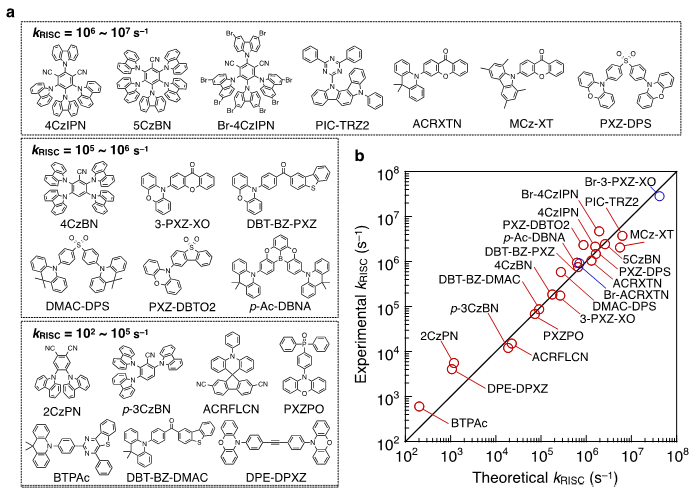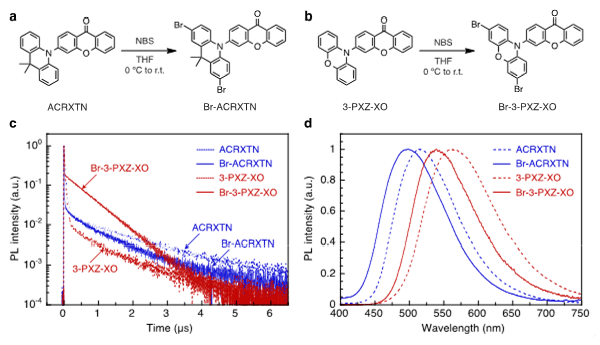The joint research team of RIKEN and Hokkaido University developed a method to predict rate constants of reverse intersystem crossing (RISC)(1) associated with light emission efficiency of organic semiconductors used for Organic Light-Emitting Diode (OLED)(2) through quantum chemical calculations with computers.
Thermally activated delayed fluorescence (TADF) materials have been expected to be the next-generation OLED materials. One of the challenges for the practical application of the materials is development of TADF materials with faster RISC. Our developed method has demonstrated accurate prediction of RISC rate constants for various TADF materials. Organic semiconductors designed based on this prediction method presented high RISC rate constant of 107 per second or higher. In the future, with materials informatics studies using the method in combination with machine learning, we would be able to establish theories and scientific principles, which would lead to drastic improvement in efficient virtual screening and device performance of OLED materials.
The research was conducted by Naoya Aizawa and Yong-Jin Pu, researchers at RIKEN Center for Emergent Matter Science (CEMS), Assistant Professor Yu Harabuchi and Professor Satoshi Maeda from Department of Chemistry, Faculty of Science, Hokkaido University and Institute for Chemical Reaction Design and Discovery (WPI-ICReDD), Hokkaido University under the research area: Advanced Materials Informatics through Comprehensive Integration among Theoretical, Experimental, Computational and Data-Centric Sciences of the JST the Strategic Basic Research Program PRESTO.
(1) Reverse intersystem crossing (RISC)
Transition from a triplet to a singlet excited state. It is caused by electron spin flip by spin-orbit interaction, which is a relativistic effect. Since spin-orbit interaction in organic matters is extremely small, it is considered to occur efficiently at energy of the crossing, where the energies in the triplet excited state and the singlet excited state are equal to each other.
(2) Organic Light-Emitting Diode (OLED)
A light emitting device that uses organic semiconductors. It is used for the display of smartphones and televisions.
-

Figure 1. TADF materials examined in this study and their RISC rate constants (kRISC). - a Molecular structures of the examined TADF materials categorized by their kRISC.
- b Comparison of the experimental and theoretical kRISC.
-

Figure 2. Synthesis and photoluminescence properties of the newly designed materials. - a,b Synthetic routes to Br-ACRXTN (a) and Br-3-PXZ-XO (b).
- c,d Transient photoluminescence decays (c) and steady-state photoluminescence spectra (d) of ACRXTN, Br-ACRXTN, 3-PXZ-XO, and Br-3-PXZ-XO in a solid-state host matrix.
Program Information
- JST PRESTO
- Research Area “Advanced Materials Informatics through Comprehensive Integration among Theoretical, Experimental, Computational and Data-Centric Sciences”
- Research Theme “Design of high-performance organic semiconductors: Form computational discovery to experimental evaluation” and “Automated design of fluorescent molecules based on a conical intersection database”
Journal Information
Naoya Aizawa, Yu Harabuchi, Satoshi Maeda and Yong-Jin Pu, “Kinetic prediction of reverse intersystem crossing in organic donor–acceptor molecules”, Nature Communications. Published online August 06, 2020, doi:10.1038/s41467-020-17777-2
Contact
-
[About Research]
Aizawa Naoya
RIKEN Center for Emergent Matter Science (CEMS)
TEL:+81-48-467-8563
E-mail: naoya.aizawariken.jp
[About Program]
Tatesawa Hiroko
Department of Strategic Basic Research, JST
E-mail: presto
